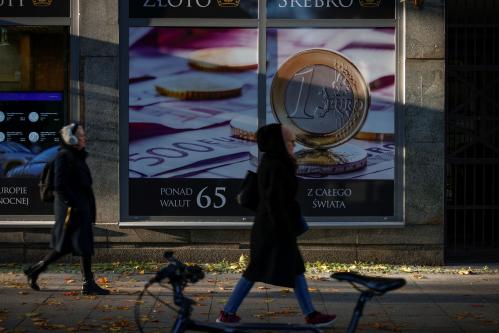In collaboration with the Financial Times (FT), Eswar Prasad of Brookings and Aryan Khanna and Caroline Smiltneks of Cornell have constructed a set of composite indexes that track the global economic recovery. The Tracking Indexes for the Global Economic Recovery (TIGER) is also featured in the Financial Times. A version of this article also appears in Project Syndicate.
The latest update of the Brookings-FT TIGER indexes (Tracking Indexes for the Global Economic Recovery) underscores a perilous moment for the world economy, with persistently high inflation, banking sector turmoil, and geopolitical risks threatening to derail growth. There are a few bright spots, with China and India, in particular, likely to register strong growth. The proliferation of risks on multiple fronts and the tightening of financial conditions are taking a toll on household and business confidence and are likely to impinge negatively on medium-term growth.
Inflation in the major economies is likely to have peaked as supply constraints ease, demand weakens, and some transitory factors such as last year’s spike in energy prices wane. Still, the persistence of inflation above targets leaves many central bankers with little choice but to continue tightening, even if less aggressively than before. In a few major advanced economies including the United States, banking sector turmoil is putting central bankers in a greater quandary. Private sector confidence has taken a hit and, with financial conditions tightening, could constrain investment and therefore GDP growth beyond this year.
The U.S. economy continues its surprising run despite numerous headwinds, with employment and consumption demand still growing robustly. Banking system stresses portend further troubles ahead. Even if these are brought under control quickly, however, there could be a hit to business and consumer confidence, which remain fragile. This could dampen private sector investment, in particular. With inflation expectations easing, a softish landing is not out of the question but depends on how quickly the Federal Reserve tries to push inflation toward its target while seeking to limit banking distress. The looming debt ceiling stalemate could disrupt financial markets and growth, with repercussions for the entire world economy.
The eurozone and the United Kingdom seem to have gotten past the worst of their woes although significant growth is hardly assured. Mild temperatures and moderating energy prices helped both economies power through a difficult winter, but high inflation remains a constraint on policies, while ambiguity about the direction of policies adds uncertainty in itself. In Japan, both domestic demand and exports remain feeble. If above-target inflation proves persistent, the Bank of Japan could face pressure to reverse yield curve control and negative policy rates, which have kept the yen weak and provided limited support to domestic demand.
The major emerging market economies have held up quite well, despite some of them experiencing high inflation and weakening currencies relative to the dollar. The overall resilience of emerging markets is a testament to their inherent dynamism, improvements in policy frameworks, and reduced vulnerability to external shocks on account of lower levels of foreign currency external debt and sizable foreign exchange reserves. Low-income and frontier economies are suffering the most on account of rising external debt service costs, weak export demand, and limited domestic policy space.
With the zero-COVID policy and the disruptive effects of its abrupt reversal behind it, China is poised to register strong growth in 2023. The government has enough room on macroeconomic policies to hit the target of about 5 percent if growth momentum weakens. After a turbulent year, the property market is still beset by price declines, which could hurt growth through both household demand and investment channels. Continuity at the helms of major economic and financial agencies constitutes a positive omen of the government’s intention to support growth with suitable policy measures and at least limited reforms. But these appointments will not dispel concerns about a renewed emphasis on a state-dominated economy, with the private sector under increasingly tight control.
India is poised for another year of strong growth, with reforms undertaken in previous years paying off, although domestic demand is showing signs of waning momentum. The room for monetary policy maneuver is limited by high (but declining) inflation, and the government has reoriented some expenditures to support demand while aiming for fiscal discipline. Private investment is constrained by a still lengthy and incomplete reform agenda as well as a banking system burdened by nonperforming loans.
Brazil and Russia are likely to register at best modest growth, weighed down by various domestic and external factors. The Brazilian government’s attacks on the central bank could damage the economy and roil financial markets. Russia’s economy, which was flailing last year due to sanctions and the disruptive effects of its invasion of Ukraine, seems to have stabilized.
A number of middle- and low-income economies with high levels of foreign currency debt and large current account deficits, such as Ghana and Sri Lanka, are vulnerable to tightening conditions in global financial markets. Erratic domestic policies in countries such as Turkey and Venezuela are exacerbating their frailties. A stronger dollar, fueled by further U.S. rate hikes and perhaps also a flight to safety if turmoil continues, could add to these pressures. With global demand weak, currency depreciation and stronger exports will not cushion these economies.
Policymakers, especially central bankers, are floundering as they hit the limits of their tools in an environment of rapidly multiplying risks. Their actions are keeping growth from collapsing but also exposing the frailties of financial systems in the major economies and adding to concerns about medium-term growth. More fundamental supply-side, labor market, and financial reforms that generate higher productivity growth remain the best path to rebuild private sector confidence and enhance durable growth.
The Brookings Institution is committed to quality, independence, and impact.
We are supported by a diverse array of funders. In line with our values and policies, each Brookings publication represents the sole views of its author(s).








